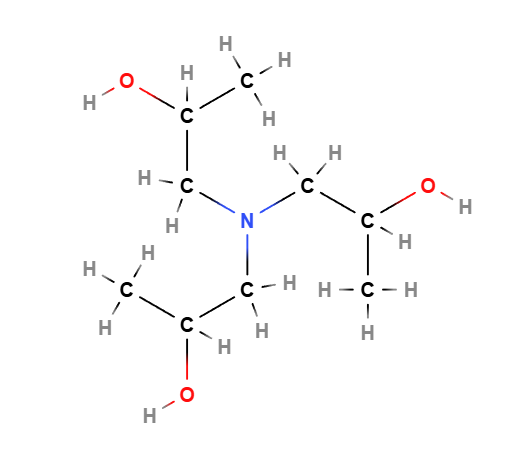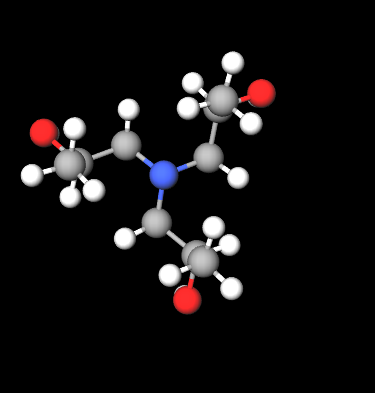| "Descrizione" by admin (19549 pt) | 2024-Oct-21 12:24 |
Triisopropanolamine (TIPA) is a multifunctional compound that serves as a surfactant, emulsifier, and pH balancer in various cosmetic and personal care formulations. It is an organic compound derived from the reaction of isopropanolamine with isopropyl alcohol. Triisopropanolamine is valued for its ability to stabilize emulsions, improve texture, and enhance the overall performance of products.
Chemical Composition and Structure
The chemical composition of Triisopropanolamine includes:
- a tri-alkanolamine with the molecular formula C9H21NO3, consisting of three isopropanol groups attached to a nitrogen atom.
Structurally, triisopropanolamine features a branched-chain structure that allows it to interact effectively with both hydrophilic and hydrophobic components in formulations, contributing to its emulsifying and stabilizing properties.
Physical Properties
Appearance: Typically a clear, colorless to pale yellow liquid.
Solubility: Soluble in water and alcohol; can also dissolve in oils to some extent.
pH: Slightly basic, generally around 8-10 in solution.
Odor: Mild, characteristic of amines.
Stability: Stable under normal storage conditions; sensitive to extreme pH and temperature.
Production Process
Synthesis: Triisopropanolamine is produced through the reaction of isopropanolamine with isopropyl alcohol in a controlled environment to ensure complete reaction and desired properties.
Purification: The product is purified to remove unreacted materials and impurities, typically through distillation or filtration.
Formulation: Purified triisopropanolamine is incorporated into various cosmetic products, enhancing their texture and stability.
Applications
Medical: Occasionally used in pharmaceutical formulations as a pH balancer or stabilizer.
Cosmetics: Commonly found in creams, lotions, shampoos, and conditioners for its emulsifying and stabilizing properties.
INCI Functions:
Buffering agent. It is an iingredient that can bring an alkaline or acid solution to a certain pH level and prevent it from changing, in practice a pH stabiliser that can effectively resist instability and pH change.
Cosmetic safety
Restricted cosmetic ingredient as III/62 a Relevant Item in the Annexes of the European Cosmetics Regulation 1223/2009. Substance or ingredient reported: Trialkylamines, trialkanolamines and their salts
Product Type, body parts (a) Leave-on products (b) Rinse-off products
Maximum concentration in ready for use preparation (a) 2.5%
Other (a) (b) - Do not use with nitrosating systems - Minimum purity: 99% - Maximum secondary amine content: 0.5% (applies to raw materials) - Maximum nitrosamine content: 50 microgram/kg - Keep in nitrite-free containers
Food: Not typically used in food products, but may find applications in food-related packaging.
Industrial Uses: Used in industrial formulations, including cleaners and coatings, for its emulsifying and surfactant properties.
Environmental and Safety Considerations
Triisopropanolamine is generally regarded as safe for use in cosmetics when applied according to recommended guidelines (1). However, it may cause skin or eye irritation in sensitive individuals. Responsible sourcing and formulation practices are essential to ensure that the ingredient is free from harmful contaminants and produced sustainably.
 |  |
Molecular Formula C9H21NO3
Molecular Weight 191.27 g/mol
CAS 122-20-3
UNII W9EN9DLM98
EC Number 204-528-4
Synonyms:
1,1',1''-Nitrilotripropan-2-ol
Tri-2-propanolamine
TIPA
References__________________________________________________________________________
(1) Writer, C. I. R. (2024). Safety Assessment of Diisopropanolamine, Triisopropanolamine, Isopropanolamine, and Mixed lsopropanolamines as Used in Cosmetics. The Expert Panel for Cosmetic Ingredient Safety members are: Chair, Wilma F. Bergfeld, M.D., F.A.C.P.; Donald V. Belsito, M.D.; David E. Cohen, M.D.; Curtis D. Klaassen, Ph.D.; Allan E. Rettie, Ph.D.; David Ross, Ph.D.; Thomas J. Slaga, Ph.D.;Paul W. Snyder, D.V.M., Ph.D.; and Susan C. Tilton, Ph.D. The Cosmetic Ingredient Review (CIR) Executive Director is Bart Heldreth, Ph.D., and the Senior Director is Monice Fiume, M.B.A. This safety assessment was prepared by Preethi Raj, M.Sc., Senior Scientific Analyst/Writer, CIR.
| Evaluate |

